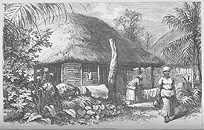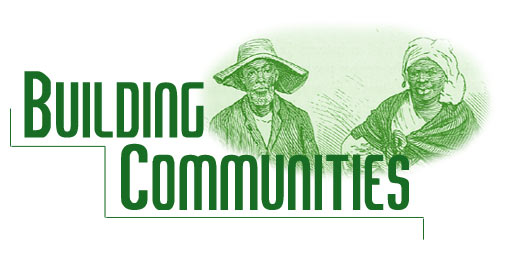
With
abolition, the freed slaves had to regroup and to find a way of structuring
their lives. The three essays in this section explore issues related
to the building of new communities. Together, these studies explore
race, labor, and education in the post-emancipation communities of
Jamaica, Barbados, and Haiti.
How
did the darkness of one's skin weigh in politics, marriage and family,
and child education? Kiaira Bell's essay shows that white observers
tried to subdivide people of color into discrete categories, ranging
from a mulatto, who was one half black and one half white to the mestees,
who were only one eight black. Those closer to the  white
end of the spectrum saw themselves as better than the other people
of color because many of them were able to pass as white. Nonetheless,
following emancipation, people of color enjoyed many political advances
politically. However, for families of color in particular, emancipation
did not wipe out racism, which continued to shape the choices that
women, in particular, could make. Few marriages took place among people
of color because for the most part, females believed that it was more
reputable to be the kept mistress of a wealthy white man than to marry
a Negro or another person of color. Although white men would never
marry women of color, many would often openly abandon their wives
and children to be in her company. The children of these relationships
would not be exempt from Jamaican society's obsession with grades
and degrees of color.
white
end of the spectrum saw themselves as better than the other people
of color because many of them were able to pass as white. Nonetheless,
following emancipation, people of color enjoyed many political advances
politically. However, for families of color in particular, emancipation
did not wipe out racism, which continued to shape the choices that
women, in particular, could make. Few marriages took place among people
of color because for the most part, females believed that it was more
reputable to be the kept mistress of a wealthy white man than to marry
a Negro or another person of color. Although white men would never
marry women of color, many would often openly abandon their wives
and children to be in her company. The children of these relationships
would not be exempt from Jamaican society's obsession with grades
and degrees of color.
Education
is essential in building a community, especially among children, as
they are being groomed to be the new leaders of the community. Observers
noted that in schools in Kingston, there was not a lot of division
along color lines and students were thoroughly intermingled. School
superintendents wrote in letters that children of color were equal
in both their ability and conduct to white students. Some children
were even sent to Great Britain to study with white students, particularly
the offspring of the men of fortune, where they received a liberal
education.
How did
access to education change with the end of slavery? When the British
decided to free the slaves on Barbados, they did so through a system
called apprenticeship. Apprenticeship was a form of free labor wage
because ex-slaves were paid for their work, but they were obligated
to work for a specified set of hours and for a specified person. This
alternate form of slavery began in 1834 and it was not until 1840
that slavery was totally abolished on the island. Various rights and
freedoms were granted to the semi-freed slaves, but many rights and
freedoms were withheld. Still, once apprenticeship began, education
on the island began to flourish. During apprenticeship and when emancipation
finally became a reality, education was a priority for ex-slaves.
The immediate building of school and the allocation of funds from
the government were important issues to both the newly freed slaves
and some of the government officials on the island.
 How
did the freed slaves organize themselves into workforce that labored
for their own, their families', and their community's benefit? The
plantation workers in Haiti faced this problem. While some white travelers
claimed that 19th-century Haitians were happy children of nature who
know nothing of work, others saw deeper. A transformation was taking
place, one that, for instance, claimed the land with a new language.
Generously citing this creole language, Aubin shows that the transformation
was not merely a transplantation of Africa; rather, it was something
new. In addition, the example of the coumbite or communal labor force
is important because, though is has African elements, it is a particularly
Haitian product of the era of emancipation.
How
did the freed slaves organize themselves into workforce that labored
for their own, their families', and their community's benefit? The
plantation workers in Haiti faced this problem. While some white travelers
claimed that 19th-century Haitians were happy children of nature who
know nothing of work, others saw deeper. A transformation was taking
place, one that, for instance, claimed the land with a new language.
Generously citing this creole language, Aubin shows that the transformation
was not merely a transplantation of Africa; rather, it was something
new. In addition, the example of the coumbite or communal labor force
is important because, though is has African elements, it is a particularly
Haitian product of the era of emancipation.
Slaves
were not given the opportunity to seek an identity as a people with
an experience of the world as valid as that of their masters. Instead,
they were given a prescribed role and were deprived of language and
learning. Their black skin was a dead end. Through the struggle of
resistance and emancipation, the bandages of ancient wounds were torn
off, revealing a people now struggling to find its equal place among
its former masters. The darkness of one's skin remained important,
opening and closing doors based on an elaborate system of what was
privileged. Access to education became a priority, redefining skills
and values. Labor practices changed as descendants of slaves became
new masters of the coumbites. All these elements were important in
the building of communities, and of the cultures that sustained them.

